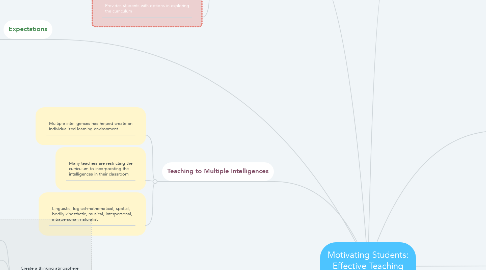
1. Expectations
1.1. The Effect of Expectations
1.1.1. Students perceived as low achievers receive less praise and more criticism
1.1.2. Low achievers experiences more rudeness and inattentiveness from teachers
1.2. Students' Expectations
1.2.1. If the teacher expects a student to do poorly, then the student will expect just as much
1.2.2. Students take cues from their teacher
1.3. How Expectations Develop
1.3.1. Expectations are associated with a student's cultural/racial background, gender, or SES
1.3.2. Reading ability is a crucial factor
1.3.3. Our expectations are influenced by labels
2. Differentiated Instruction
2.1. All students learn the same essential skills and content, just in their own ways
2.2. Differentiation is all about meeting individual needs of students with best=practice instruction
2.3. Takes many different forms
2.4. Provides students with options in exploring the curriculum
3. Teaching to Multiple Intelligences
3.1. Multiple intelligences has helped create an individualized learning environment
3.2. Many teachers are restricting the curriculum to incorporating the intelligences in their classroom
3.3. Linguistic, logical-mathematical, spatial, bodily kinesthetic, musical, interpersonal, intrapersonal, naturalist
4. Teaching Thinking Skills
4.1. Create a thinking atmosphere
4.1.1. Thinking takes practice
4.1.2. Realize academic skills aren't the same as thinking
4.1.3. Start early, even preschoolers should be challenged to think
4.1.4. Give children something to think about
4.1.5. Teach children how to be critical thinkers
4.2. Ask good questions
4.2.1. Questions assess what students already know, set the stage for a new lesson, determine what factual information students absorb, and even stimulate higher level thinking
4.2.2. Ask knowledge-level questions
4.2.3. Ask questions such as why? What if? How do you know?
4.3. Encourage creativity
4.3.1. Role-play, ask students to play the role of someone else
4.3.2. Pose "what if?" questions
4.3.3. Solve open-ended problems
5. Internal vs. External Motivation
5.1. External Motivation
5.1.1. When we expect external rewards for completing an activity, that is external motivation.
5.1.2. External rewards can encourage students to become more efficient learners
5.2. Internal Motivation
5.2.1. Most important and most long-lasting
5.2.2. Fueled by curiosity, it is the motivation we are born with
5.2.3. Sadly, this is a quality that many students lose by upper elementary grades
5.3. Leading by Example
5.3.1. Teachers serve as important role models
5.3.2. Present learning tasks in a positive way
5.3.3. Stress the value of the task by pointing out how knowledge can bring pleasure and satisfaction!
6. A Few Words on Praise
6.1. External reward
6.1.1. Is often overused
6.1.2. Verbal praise is often not an effective reward
6.2. Praise can undermine efforts to encourage if it is used inappropriately
6.3. Praise is effective when it is...
6.3.1. sincere
6.3.2. delivered privately
6.3.3. specific
6.3.4. focused on individual improvement
7. Giving Children Choices
7.1. Students who are given choices in what and how they learn will learn more and even have a better attitude about it
7.1.1. Key component of a learner-centered approach to education
7.2. Without choices in the classroom, children will burn out
7.3. Four aspects to academic decisions: what to learn, how to learn it, how well, and the why
7.4. When giving choices to students, it is important as the teacher to teach students to make responsible choices and to take control of their own learning
8. Active Teaching
8.1. Direct instruction: teacher organizing and leading learning activity
8.2. Teachers carefully structure academic tasks
8.3. This type of teaching helps students to learn, it keeps them motivated and attentive
8.3.1. The need for active teaching varies with grade level
